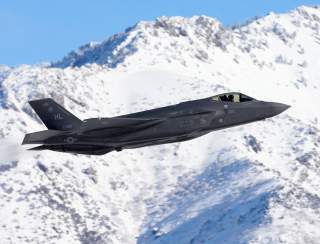Why Iran's Anti-Air System Can't Touch the F-35 Stealth Fighter
A joke?
Key point: The F-35 is a top-of-the-line aircraft. No matter how good Iran's defenses are, they aren't that good.
Iran has announced a new anti-aircraft missile system.
But is it new, or a knockoff of a foreign weapon?
The new surface-to-air missile is called the Khordad 15. Iran’s Defense Minister, Brigadier General Amir Hatami, said at the unveiling ceremony that the system is “capable of detecting fighter jets and combat drones from 150 kilometers [93 miles] away and of tracking them within a range of 120 kilometers [75 miles],” according to Iranian state media. “The system, he added, can also detect stealth targets at a distance of 85 kilometers [53 miles] and engage and destroy them within a range of 45 kilometers [28 miles].”
Hatami claimed the Khordad 15’s Sayyad 3 missiles simultaneously detect, intercept, and destroy six targets, and can be ready to engage those targets in less than five minutes.
Hatami also said that “air defense system is equipped with a phased array radar and independent launch pads and can effectively take action against various aerial targets, such as reconnaissance aircraft, bombers and tactical warplanes,” according to the Tehran Times.
Iranian video showed a flatbed military truck with a rotating, rectangular launcher on the bed. The launcher appeared to contain four missile canisters in two rows of two canisters each. Another truck appeared to mount a rotating slab-shaped radar antenna.
Iranian press boasted that the Khordad is an Iranian design. “Iran has recently made major breakthroughs in its defense sector and attained self-sufficiency in producing military equipment and hardware despite facing sanctions and Western economic pressure,” said Iran’s Press TV.
But that’s not quite true. Iran has a track record of copying other nations’ weapons, including the notorious Iranian Kowsar fighter that looks remarkably like the American F-5 supplied to the Shah’s air force before he was overthrown in 1978.
Iran’s Sayyad 1 anti-aircraft missile was derived from the Cold War Russian SA-2 missile, or more likely spawned by SA-2 knockoffs built by China and North Korea. The Sayyad 2 went in production in 2013, and has a maximum range of about 150 kilometers (93 miles), according to Benham Ben Taleblu, a researcher at the Foundation for the Defense of Democracies.
“Like most Iranian weapons, the Sayyad SAM has its origins in foreign military hardware. The Sayyad-2 is based on the American SM-1 (RIM-66), which the Iranian Navy reportedly received from the US prior to the 1979 Islamic Revolution,” Taleblu writes.
“In 2013, Iranian outlets reported that the country’s S-200 SAM system (which uses a rail-launcher) would be equipped with the Sayyad-2. Iran has since developed a physically longer and longer-range Sayyad SAM for the Talash system called the Sayyad-3.”
The Sayyad 3 may very well be based on a foreign design (it does somewhat resemble a Sayyad 2). In either case, the weapon was unveiled amid rising tensions between Iran and the U.S. The Trump administration has abandoned a multinational agreement with Iran that was supposed to lift international sanctions in return for Iran agreeing to restrict its nuclear weapons development. The U.S. has since reimposed sanctions that have badly damaged Iran’s economy. After claims that Iran was preparing to retaliate by striking U.S. targets in the Persian Gulf, the aircraft carrier USS Abraham Lincoln was dispatched to the region.
The Sayyad 3 will probably not prove much of a deterrent to U.S. military operations, should a conflict erupt.
Michael Peck is a contributing writer for the National Interest. He can be found on Twitter and Facebook. This first appeared in 2019.
Image: Reuters

